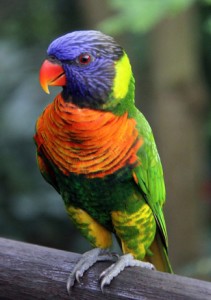
The rainbow lory is one of the most stunning and beautiful companion birds available today. Lories, in general, need more care and attention than your more common companion birds due to their highly specific dietary and housing requirements. However, they are well worth the extra time and expense.
- Color
Multi Colored - Size
small - Lifespan
Up to 30 years - Sounds
Chatterer, Vocal communicator - Interaction
Social
What Is A Rainbow Lory?
 The rainbow lory, also called the rainbow lorikeet, is part of more than 130 species and subspecies in the subfamily Loriinae and is one of the most stunning and beautiful companion birds available today. Lories, in general, need more care and attention than your more common companion birds due to their highly specific dietary and housing requirements. However, they are well worth the extra time and expense.
The rainbow lory, also called the rainbow lorikeet, is part of more than 130 species and subspecies in the subfamily Loriinae and is one of the most stunning and beautiful companion birds available today. Lories, in general, need more care and attention than your more common companion birds due to their highly specific dietary and housing requirements. However, they are well worth the extra time and expense.
The rainbow lory, about 10 to 12 inches in length, is aptly named, its feathers graced with all shades of the rainbow, each subspecies possessing more or less of a particular plumage color, enabling experts to tell them apart, though there is no visible difference between the sexes. Rainbow lories are hard to miss, with their bright reds and greens, vibrant blues and violets, and splotches of lemon-yellow flowing into intense oranges. Their dramatic appearance and wonderful temperament make them a popular companion among fanciers.
Native Region / Natural Habitat
In the wild, rainbow lories are native to Australia and eastern Indonesia.These birds are found in large flocks. They roost in trees at night numbering in the hundreds and thousands. They reach sexual maturity at about 2 years of age, and generally rear two babies per clutch, as opposed to many other parrots this size, which may have six or more chicks at a time.
Care & Feeding
Lories bathe exuberantly and often, so you should be prepared to invest in a shower perch, a mister, and a shallow bath for the cage. Another funny quirk is the Rainbow’s penchant for sleeping laying upside-down on its back, often rattling the nerves of its guardians.
The rainbow lory is more than just bright on the outside. This is a highly intelligent bird, able to learn tricks and other behaviors. Because it’s so intelligent, it is also a capable escape artist, so cage door locks are a necessity.
Lories love toys, especially jingling and rattling things. Because they have a tendency to become bored, it’s important to rotate toys at least weekly. You can never have too many toys for a rainbow lory, and, in fact, one bird should have a rotation of no less than twenty toys. The Rainbow can be hard on its toys, so they should be safe, with no strings to get tangled in and no small spaces to catch a toe or beak.
Because of all of these specific care requirements, the first-time bird owner may want to steer clear of lories until he or she has a bit more experience.
Most lories do not get along with other bird species, and can even become vicious with birds of their own species. They are extremely territorial and should never be left unsupervised with other birds. They have been known to kill birds far larger than themselves.
Lories require a much different diet than that of other parrots because their gizzard is not as powerful and is unable to crush seeds. Though some lories will crack a few seeds, their main diet is fruit, such as bananas, oranges, melon, and apples; they also eat flowers, such as hibiscus; but the staple diet in captivity is a nectar made from juice with specially formulated lory-diet powder mixed into it. Lories have a specialized brush-like tongue that is used to pick up nectar and pollen. This liquid diet causes very loose droppings that tend to be sprayed, often outside the cage. Someone living with a lory will spend a lot of time cleaning. There are dry diets specifically for lories that will make the droppings less soft, but this diet should only be a supplement to the liquid and fresh food and flower diet. Lories are also partial to mealworms and grubs.
Personality & Behavior
The lory personality is intense, in general. This is not a shy species. The rainbow lory is bubbly and enthusiastic, the “coach” of the bird world, encouraging play whenever its favorite human is around. These birds are constantly busy and lively, allowing little time for rest. Their antics are extremely entertaining for most people, but they can become a little much for someone that’s used to a more laid-back companion.
Playtime is crucial for the lory, and the Rainbow will relish time out of the cage to spend with its guardian. This need should be indulged as often as possible. A rainbow lory that’s left alone too often will develop behavior disorders and may begin to self-mutilate. Warn new guardians to be watchful when the bird is out of the cage, however, because this active bird tends to be mischievous and destructive, and will get into trouble quicker than someone can save it from harm. Because this bird is so excitable and intelligent, it is also often nippy, and will generally bite only out of excitement or fear (usually of being put back into the cage!).
Speech & Sound
Lories can be noisy, and the rainbow lory is no exception. Their voice is high-pitched, with a squeaky-squawky repetitive “bark.” They are wonderful talkers, and will learn many words and phrases, learning to speak them clearly and often, though the rainbow lory in particular isn’t the best talker in the family.
Health & Common Conditions
A major health concern for the rainbow lory, or for any lory, is food spoilage. You must change a lory’s liquid food often, especially in warm weather, when the rich food rapidly becomes infected with bacteria. Fruit will spoil too if it’s left for even a few hours in the cage. This can cause infections of the crop and even general toxicity. A rainbow lory can live 20 to 30 years, but it is the lucky and unusual lory that makes it that long. There is a common myth that lories don’t need water. This is untrue and should be dispelled immediately.
Rainbow Lory Populations In The Wild
Rainbow lories are available in pet stores, avian-specialty stores, bird breeders, as well as occasionally for adoption from avian-rescue organizations.
Have Questions? Contact Us!
Lafeber is a family company dedicated to its customers and the health of all animals. We really value feedback, and if you have any questions or concerns, please do not hesitate to contact us.
Please email: customerservice@lafeber.com Or call us and a real person will pick up the phone: (815) 888-4040









